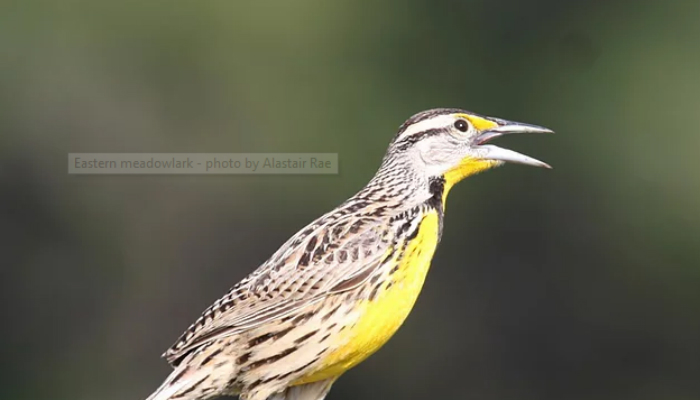Last Call for the Meadowlark

David Cordray has written a scenario in the future that paints a picture of what may happen to bird species in the grasslands. He says: “While this blog post is fictional, the threat of grassland birds disappearing from our landscape is very real. Grassland bird numbers have fallen drastically in the last 50 years, and the negative trend continues.”
A young man sits on a dolomite limestone bench protruding from a knoll overlooking a large, open expanse of prairie grasslands. He’s a zoology student, and his research project involves performing breeding bird surveys across a collection of sites. He flips through a thick data collection of previous surveys from this site and stops abruptly when he sees the field researcher’s name on the year 2020 survey. It’s his mother’s name. And, like him, she chose this exact spot 25 years ago to listen for and record the breeding calls of grassland bird species.
Intrigued, but with ears tuned for the calls of birds, he reads the site description in his mother’s hand-written notes. Fortunately, he thinks, this site belongs to a local conservancy and is well cared for by a devoted friends’ group. The large leadplant just south of the bench is still here. Little bluestem, June grass, needle grass, hoary puccoons – are all still here, too. So is the sedge meadow in the northeast corner of the property. With one exception, the site seems as it was in his mother’s day. Gone are the open fields outside the conservancy’s borders, replaced forever by condominiums, service roads and other quick-convenience services of modern daily life.
He reads on in his mother’s notes. She recorded hearing a Henslow’s sparrow roughly 60 meters northwest of his position. His eyes leave the notebook and scan to the northwest. For a brief moment, hopeful anticipation creeps in, but he quickly pushes it back. He knows Henslow’s sparrows, rare even in his mother’s time, haven’t been seen or heard in this region for years. He holds his blank stare to the northwest. His mind lost in time somewhere between then and now. A dog barks, breaking his void, and he returns to the notes.
He reads his mother’s description of bobolink courtship behavior. He keeps his head in a nodding position, closes his eyes, and replays her account in his mind. He imagines seeing a black bird with a white back flutter by, singing a bubbling, superlative song. Excited, he follows the bird’s low fight in his imagination, and sees a dozen or more birds with vivid straw-colored patches on their heads seemingly floating just above the grass. A chorus of electrified, metallic, bubbling songs break out behind him, and he turns to see four more birds with off-white head patches chasing a yellowish-brown bird with dark brown streaks just over the top of the grasses. He thinks, so this is what my mother called a bobolink immersion – an ancient courtship ritual comprised of nature’s finest symphony and ballet. He opens his eyes. His emotions tugging at his heart from polar extremes. Happy to experience the bobolinks vicariously through his mother’s notes, but saddened he will likely never experience it himself.
He reads on. Her words describe the commanding presence of the Eastern meadowlark. The words fade to darkness, and again he finds himself with his eyes closed, imagining the prairie full of meadowlarks. Male meadowlarks are perched on high points scattered across the prairie landscape. Sentries to their small territories of grass and flowers, they allow free access to females, while vigorously denying passage to other males. He watches a male bird close to him. The bird reaches its black bill into the sky, puffs out its bright yellow breast feathers, and emits a musical, flute-like call: “spring is here.” Other male birds follow suit, and soon one bird after another jumps into the air fluttering its wings with tail feathers cocked upward and feet dangling.
The young man sits, eyes still closed, determined to hold onto the meadowlark scene playing in his mind. Those wonderful calls, he thinks. Musical three-tone, flute-like whistles dropping in pitch – “SPRING Is here, SPRING Is here, SPRING Is here …”
Somewhere in the sequence of meadowlark calls, dream state shifts into present awareness, and he realizes he is actually hearing a meadowlark. Field notes scatter in the gentle wind, as he fumbles for his binoculars. Swinging wildly with the binoculars, he occasionally catches an image of a meadowlark sweep through his field of view. “Calm down,” he tells himself. He draws in a couple of deep, stabilizing breaths, raises the binoculars to his eyes, and finds himself staring at a singing Eastern meadowlark.
He surprises himself with his reaction to this significant find. Joy and elation are overcome with a sense of urgency. This is the last call for the meadowlark. The reins are now in his hands to sway public opinion to care about a dying species. Is there any reasonable possibility he can succeed when others before him failed?
Walking back to the parking lot, the meadowlark has stopped calling. He thinks. Is it worth dedicating part of my life to help a species whose fate is likely sealed? A scene pops into his mind. It’s sometime in the future, he’s back at this prairie, accompanied by his six-year-old daughter. They’ve just been through a long, dark winter. The air is warm, and they both sit on a dolomite limestone bench protruding from a knoll overlooking a large expanse of prairie grasslands. A musical flute-like call “spring is here,” rolls across the prairie. His daughter, beaming, looks up at him and says: “Daddy, it’s a meadowlark!”
The answer is suddenly clear. He has to try.
Originally published in Environmental Returns.


